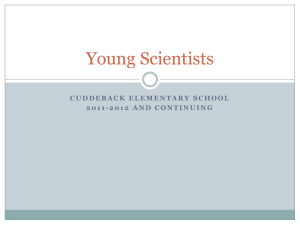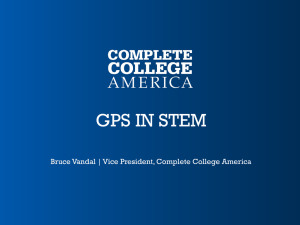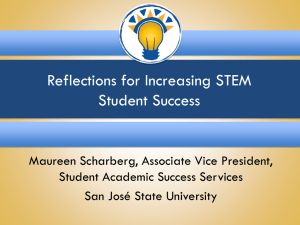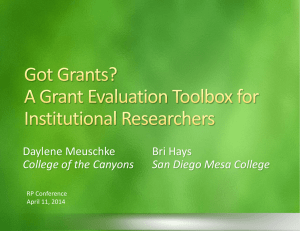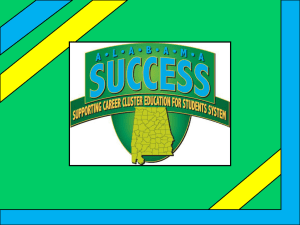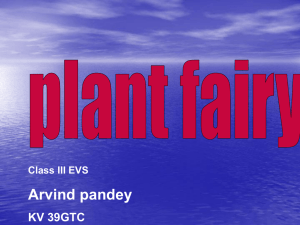Women in STEM: Outcomes from *Un Foro de Mujeres en STEM* de la
advertisement
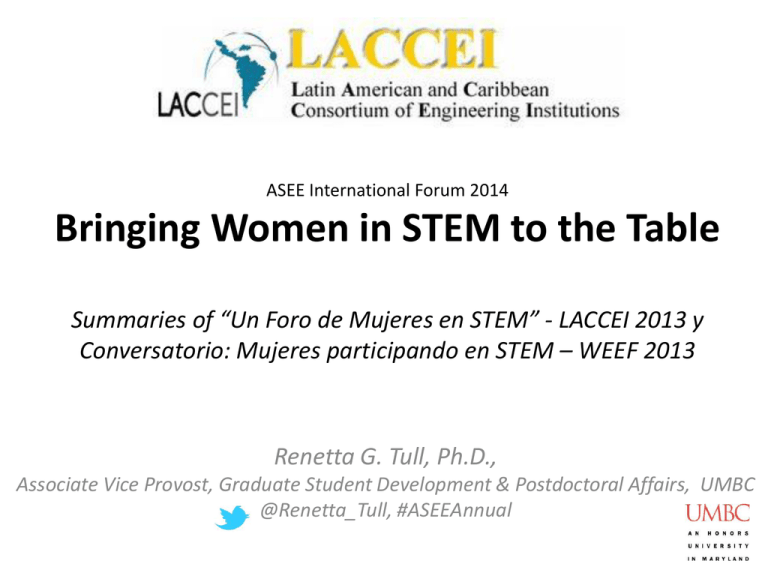
ASEE International Forum 2014 Bringing Women in STEM to the Table Summaries of “Un Foro de Mujeres en STEM” - LACCEI 2013 y Conversatorio: Mujeres participando en STEM – WEEF 2013 Renetta G. Tull, Ph.D., Associate Vice Provost, Graduate Student Development & Postdoctoral Affairs, UMBC @Renetta_Tull, #ASEEAnnual PROGRAM AGENDA WOMEN IN STEM FORUM, LACCEI 2013 Opening Comments: Short Introduction & Importance of Forum - Renetta Tull Welcome: Maria Larrondo Petrie, LACCEI Director Statement of welcome: Bevlee Watford, American Society of Engineering Education Setting the Stage: Data and Background State of Women in STEM in the Caribbean and Latin America. Marta Beltran Martinez - Organization of American States (OAS) Successful Projects Project Synopsis: ADVANCE Hispanic women in STEM, Beatriz Zayas, Universidad Metropolitana, Puerto Rico. Includes: “A President's Perspective on Facilitating Women's Leadership" from Carlos Padin - Chancellor, Universidad Metropolitana, Puerto Rico . Project Synopsis: New Mexico State NSF LSAMP/REU - FOCUS: undergraduate women, Delia VallasRosales, Industrial Engineering, New Mexico State University Overcoming Barriers Implicit Bias: Fixing the System at the Administrative Level. Autumn Reed – Office of the Provost, University of Maryland Baltimore County, UMBC ADVANCE Women, leadership, and financial management. Claudia Medienta Cardona, Universidad de San Buenaventura, Cali, Colombia 2 Underrepresentation of women in many Science &Technology disciplines: Cultural biases and prejudices Lack of exposure to S&T careers Lack of information and knowledge about S&T careers Lack of support and provisions for combining professional work and family duties Discrimination in appointment, retention and advancement of women Lack of mentors and role models Lack of leadership training Hostile work environment Example: % of women enrolled in engineering careers: Shared by Marta Beltran -Chile: 15% (2007) - Costa Rica: 20% (2004) - UNAM Mexico: 18% (2009) 3 Shared by Marta Beltran 4 Data Overview from the Faculty Work Climate Survey, Oct. 4, 2012 (adapted from ADVANCE, University of Illinois at Chicago WISEST) Selected Results: N=39: 38% Assistant Professors; 30% Associate 25% Full. More productivity in teaching than research 5+ undergraduate classes in one year • 54% are supported by research grants • 41% of papers submitted by the participants for publication have been accepted. 5 Data Overview from the Faculty Work Climate Survey, Oct. 4, 2012 (adapted from ADVANCE, University of Illinois at Chicago WISEST) Satisfaction: Positive interactions with colleagues, efforts to recruit women and promote them into leadership positions. However, too few women and difficulty retaining them. Dissatisfaction: (Lack of) Equipment and supplies to conduct research, infrequent maintenance of equipment, feeling like a full and equal participant in departmental problemsolving and decision making, having a voice in resource allocation in the department. Men receive more feedback and have more informal social networks Focus on Personal Life 50% +: career progression slowed by personal responsibilities 61% have cared/are caring for dependent children 31% have cared/are caring for dependent others. Difficulty in adjusting their work schedules, department meetings occurring outside of the 9-5 workday in the general academic climate and structural practices (e.g., when meetings occur.) 6 Negotiation and Power (Negociación y Poder), Prof. Gilda Barabino, Georgia Tech (New Eng. Dean, CCNY, July 2013) Shared by Beatriz Zayas 7 Major Barriers Facing Women in Engineering • Engineering: too much pressure (HW, projects, male oriented) • Competitiveness: individualism • Lack of role models Home School Professionals Shared by Delia Valles Rosales • Mathematics. Generally affect both genders. High School math preparedness and readiness. Gap between pre and college algebra and calculus ready. – 100 freshmen students not calculus ready as of spring 2012. At the end of spring 2012, 40% transferred to other disciplines than engineering. New Mexico State University 8 Shared by Delia Valles Rosales 9 Implicit Bias: Fixing the System at the Administrative Level WOMEN IN STEM FORUM, LACCEI 2013 Definitions A. Explicit Bias-Stated clearly and in detail, leaving no room for confusion or doubt, purposeful. B. Implicit (Unconscious) Bias - Hidden or unconscious, not plainly expressed, and/or easily recognized, everybody has them. C. Examples of Commonly Held Beliefs About Women in S&E * Women are not as good in mathematics as men * The underrepresentation of women in STEM is a function of how many women are qualified to enter these positions * Women are not as competitive as men and just do not want jobs in academia * Women faculty are less productive than male faculty * Women are more interested in family than in careers (Beyond Bias and Barriers, 2007, S-4) 10 Shared by Autumn Reed Empirical Studies of How Implicit Bias Operates in Recruitment Process Gender 1) Trix & Psenka (2003) study of 300 recommendation letters for medical school faculty found : * Letters written for women are shorter. * Provide minimal assurance (refer to compassion, teaching, and effort not their achievements, research, and ability). * Portray women as students and teachers rather than researchers and professionals. 2) Steinpreis et al., (1999) study of gender bias in CV evaluation with 118 male and female participants evaluating the same CV with a randomly assigned male or female name found: * Both male and female evaluators gave the male applicants better evaluations in teaching, service, and research. 11 Shared by Autumn Reed * More likely to hire male over female applicant. Shared by Claudia Patricia Mendieta Cardona Shared by Claudia Patricia Mendieta Cardona 13 Women in STEM Survey, Aug. 2013 Demographics: N=20, 13 Female, 7 Male • Countries: US, Panama, Peru, Colombia, Ecuador, Brazil, England, Chile Results • I have been involved with activities to advance women in STEM: – Not at all + somewhat = 55%, Mostly + Completely: 45% • This forum increased my in being involved with advancing women in STEM: – Mostly + Completely: 85% • This forum increased my awareness about approaches for advancing women in STEM: – Mostly + Completely: 85% • I plan to have future involvement with activities to advance women in STEM: – Mostly + Completely: 80% 14 Discussions from Working Group • QUESTION: Biggest needs? • ANSWER 1: Involvement by men who believe in and have passion about advancing women in STEM. (Champions) [Need those who have good training models for recruiting and advancing women.] SUGGESTED SOLUTIONS • Workshop for faculty; • LACCEI Deans Council open discussions; • Plenary presentations about this issue; • Panel of deans presenting to each other to discuss what they have done that was successful and why; • Campaign to get the concept into minds and forefront; • Training Deans before panel to make sure they come from a point of awareness. 15 Discussions from Working Group • QUESTION: Biggest needs? • ANSWER 2: • Lack of mentoring on all levels • Need virtual mentoring programs, mentor networking programs, private social networking sites to allow written communication and mentoring SUGGESTED SOLUTIONS • MentorNet • Implement a mentor survey or letter at conference • Assign mentors for all levels • Implement/partner with programs for girls to showcase women in STEM as role models (recruitment) 16 Discussions from Working Group • QUESTION: Biggest needs? • ANSWER 3: Connections, Partnerships, Collaborations SUGGESTED SOLUTIONS • Establishing Partnerships with groups and universities within the organization – Research collaboration “room” event – Facilitated connections with industry – Invite other women in engineering organizations to the conference – Start now, find women in engineering for the 2014 conference 17 Discussions from Working Group • QUESTION: Biggest needs? • ANSWER 4: Recognition and Visibility SUGGESTED SOLUTIONS • Establish Awards • Train women to compete for national/international awards • Keynote/plenary about Women in STEM 18 2013 “Women in STEM” WEEF, Cartagena, Colombia • Input from faculty and students from universities in Colombia and Ecuador, and members of the International Federation of Engineering Education Societies (IFEES), including LACCEI and the Korean Society of Engineering Education. • HIGH levels of engagement from several emerging women engineers who are pursuing their undergraduate studies. • Input from male students! 19 Message from WEEF 2013 “Women want to be equally recognized for their engineering talents and abilities. They also want efforts that will encourage more women and girls to enter and stay in engineering fields.” Overall, there is a call to facilitate women’s pursuit of excellence in engineering without barriers, and without detracting language or actions that would discourage participation. 20 Addressing points at LACCEI 2014 Guayaquil, Ecuador Planned: • Participation from the National Science Foundation • Female plenary keynote speaker • Speakers to address issues from 2013: – Male champions – Prizes and honorific societies – Example of research that will engage more women 21 Addressing points at LACCEI 2014 Guayaquil, Ecuador Subset of topics: Transforming Climates for the Academic Woman of Color: Facilitating Greater Understanding in the Workplace Climate and in Social Structures Loretta A. Moore (Jackson State University), Michelle D. Deardorff (University of Tennessee at Chattanooga), Evelyn J. Leggette (Jackson State University), Angela M. Kupenda (Mississippi College School of Law) Assistive Technology Research as a Mechanism to Broaden the Participation of Women, Underrepresented Minorities, and Persons with Disabilities Patricia Ordóñez (University of Puerto Rico, Rio Piedras), Kavita Krishnaswamy (UMBC), Renetta G. Tull (UMBC), Dan Ding (University of Pittsburgh), Mary Goldberg (University of Pittsburgh and Carnegie Mellon University) Promotion and Prizes: Pursuit of Excellence and Recognition in Honorific Organizations Christine Grant (North Carolina State University) 22 Women in leadership at LACCEI 2014 Guayaquil, Ecuador Women speakers, women in conference leadership roles, involvement of women faculty and women students from Ecuador: • Example: Julie Nieto Wigby, Decana investigación (Research Dean), Escuela Superior Politécnica del Litoral (ESPOL), Guayaquil, Ecuador • PROMETEO program • Women in Leadership for FLEEI LACCEI 23 Vision Expanded discussions about Women in STEM throughout Latin America (including discussions at meetings worldwide, e.g., WEEF, IFEES, Gender Summit, meetings of the professional societies.) • Opportunities for ALL women, from all socio-economic backgrounds and all regions to learn about STEM in general, engineering in particular • Exposure of women in STEM to underserved populations in LACCEI’s regions, e.g., Andean coastal regions • Advancement of women to highest ranks of leadership • Career Life Balance: Engagement of women without sacrifice to worthy traditions and family connections. 24 Acknowledgement of Support Renetta G. Tull, rtull@umbc.edu, @Renetta_Tull 25
